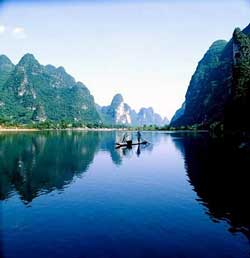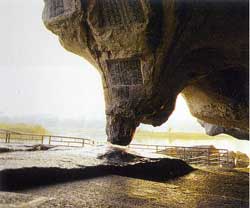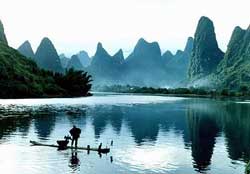|
Guilin - Best Under Heaven By Chen Jun, Congress Director ISPRS Council 2004 - 2008 Guilin is located in the northeast of Guangxi Zhuang Autonomous Region southwestern China, with a history of more than 2,000 years. The city proper covers 565 square kilometers. Over 600,000 people live in the city. Guilin is hailed by many as the most beautiful place in China and is one of the must-see destinations for most foreign tourists. According to a popular Chinese saying, "Guilin's scenery bests all others in the world." Its shapely-rising limestone towers and crystal-clear waters are often portrayed in Chinese artworks. Adding to its natural beauty are many fascinating caves. Lijiang River
Elephant Trunk Hill It is so named because of its resemblance to an elephant's sipping water from the Lijiang River with its trunk. The hill is on the western bank of the Lijiang River, 55 meters above the water, 108 meters in length and 100 meters in width. The cave between the "trunk" and the "body" is called "Moon-over-Water Cave". The sight is very representative of the landscape around Guilin. During sunset, the view is more attractive. Here is a legend about the hill. The Emperor of Heaven set out to conquer the Earth with his elephant. The elephant worked so hard to provide transport and finally got ill seriously. Some farmers saved his life. The elephant was very grateful and decided to stay on earth and help the farmers. The Emperor of Heaven was so angry. He thrust his sword into the elephant and turned the elephant into the rocky hill. A pagoda erected on top of the hill stands for the hilt of the sword. Reed Flute Cave
Fubo Hill
Yangshuo
Guilin is also a good place for understanding many ethnic minorities of China. There are Zhuang, Yao, Hui, Miao, Mulao, Maonan and Dong etc.. Each minority has its own unique customs and festivals. In the picturesque surroundings, being with local people from different ethnic groups will be an exciting experience. |
|
|
|
|

 The Lijiang River is the most important part of Guilin's scenery. It generally means the water way between Guilin and Yangshuo with 83 kilometers long. Along the Lijiang River, you can appreciate verdant - rolling hills, clear - running waters, mysterious caves and breath-taking cliffs. By a boat trip starting from Guilin, the first point of interest is the pagoda-capped Elephant Trunk Hill, long used as the symbol of Guilin. A little further downstream, the Pagoda Hill will be seen. Its hexagonal pagoda is called Longevity Buddha Pagoda and dates back to the Ming Dynasty (1368-1644). Then a series of beautiful scenes come into view, such as the Yearning-for-Husband's-Return Rock resembling a lady with her baby, the Crown Crag Hill with a big water eroded cave, which has various stalactites, stone pillars and rocks, the Picture Hill showing naturally-shaped images of nine horses in different positions, the Yellow Cloth Beach with the most beautiful water reflection of surrounding peaks, etc.. The cruise ends at the colorful market town of Yangshuo.
The Lijiang River is the most important part of Guilin's scenery. It generally means the water way between Guilin and Yangshuo with 83 kilometers long. Along the Lijiang River, you can appreciate verdant - rolling hills, clear - running waters, mysterious caves and breath-taking cliffs. By a boat trip starting from Guilin, the first point of interest is the pagoda-capped Elephant Trunk Hill, long used as the symbol of Guilin. A little further downstream, the Pagoda Hill will be seen. Its hexagonal pagoda is called Longevity Buddha Pagoda and dates back to the Ming Dynasty (1368-1644). Then a series of beautiful scenes come into view, such as the Yearning-for-Husband's-Return Rock resembling a lady with her baby, the Crown Crag Hill with a big water eroded cave, which has various stalactites, stone pillars and rocks, the Picture Hill showing naturally-shaped images of nine horses in different positions, the Yellow Cloth Beach with the most beautiful water reflection of surrounding peaks, etc.. The cruise ends at the colorful market town of Yangshuo. It is the Guilin's largest and most impressive cave, formed 600,000 years ago by a underground river. Its name was derived from reed grass, which grew in front of the cave and was used for flutes. The highest part of the karst cave is 18 meters and the widest 93 meters. The cave's length is 2400 meters. Visitors can access to the first 500 meters' section. The cave, known as Art Palace of Nature, contains an overwhelming abundance of stalactites and stalagmites. Its internal lighting system uses colorful lights to emphasize the coincidental similarity of the rock formations to birds, plants, and animals. In the atmosphere of fairyland, you may enjoy your imagination and be amazed at the power of nature.
It is the Guilin's largest and most impressive cave, formed 600,000 years ago by a underground river. Its name was derived from reed grass, which grew in front of the cave and was used for flutes. The highest part of the karst cave is 18 meters and the widest 93 meters. The cave's length is 2400 meters. Visitors can access to the first 500 meters' section. The cave, known as Art Palace of Nature, contains an overwhelming abundance of stalactites and stalagmites. Its internal lighting system uses colorful lights to emphasize the coincidental similarity of the rock formations to birds, plants, and animals. In the atmosphere of fairyland, you may enjoy your imagination and be amazed at the power of nature. It is 62 meters above the water, 120 meters long and 60 meters wide. Half of it stands in the river. "Fubo" in Chinese means "conquering waves". Since the galloping water is always blocked here and eddied, the hill is considered to have the power of subduing waves. Moreover, it was on this hill that a temple in commemoration of one ancient general named Fubo was built in the Tang Dynasty (618-907), which gave rise to the name of Fubo Hill. Rocks and stalactites as well as a cloister and pavilions compose the fantastic and unique sight of the hill. At the foot of hill lie the Pearl-Returning Cave, the Thousand-Buddha Cave and the Sword-Testing Rock. A gracious cloister and a tearoom are on the southern slope. Halfway to the hill is the Pavilion of Listen-to-Waves. Stone steps wind up towards the hill top on the western slope. The Viewing Platform on the way is an ideal spot for seeing the panorama of Guilin city.
It is 62 meters above the water, 120 meters long and 60 meters wide. Half of it stands in the river. "Fubo" in Chinese means "conquering waves". Since the galloping water is always blocked here and eddied, the hill is considered to have the power of subduing waves. Moreover, it was on this hill that a temple in commemoration of one ancient general named Fubo was built in the Tang Dynasty (618-907), which gave rise to the name of Fubo Hill. Rocks and stalactites as well as a cloister and pavilions compose the fantastic and unique sight of the hill. At the foot of hill lie the Pearl-Returning Cave, the Thousand-Buddha Cave and the Sword-Testing Rock. A gracious cloister and a tearoom are on the southern slope. Halfway to the hill is the Pavilion of Listen-to-Waves. Stone steps wind up towards the hill top on the western slope. The Viewing Platform on the way is an ideal spot for seeing the panorama of Guilin city. Yangshuo is one of the Guilin's 12 counties. As an old saying goes , "Guilin's scenery is the most beautiful in the world, Yangshuo's scenery is the best in Guilin ". Yangshuo County covers an area of 1,428 square km. There are over 20,000 hills and over 250 scenic spots. The clean and clear Lijiang River runs through Yangshuo for 56 km. Picture Hill, Yellow Cloth Beach, Xingping Village, Lotus Cave, Young Scholar Hill, Snow Lion Ridge, Big Banyan Tree, Moon Hill, and Dragon River are in Yangshuo among the most famous scenic spots of Guilin. Old buildings and bridges amongst the hills and rivers tell visitors the 1000 years history of Yangshuo.
Yangshuo is one of the Guilin's 12 counties. As an old saying goes , "Guilin's scenery is the most beautiful in the world, Yangshuo's scenery is the best in Guilin ". Yangshuo County covers an area of 1,428 square km. There are over 20,000 hills and over 250 scenic spots. The clean and clear Lijiang River runs through Yangshuo for 56 km. Picture Hill, Yellow Cloth Beach, Xingping Village, Lotus Cave, Young Scholar Hill, Snow Lion Ridge, Big Banyan Tree, Moon Hill, and Dragon River are in Yangshuo among the most famous scenic spots of Guilin. Old buildings and bridges amongst the hills and rivers tell visitors the 1000 years history of Yangshuo.